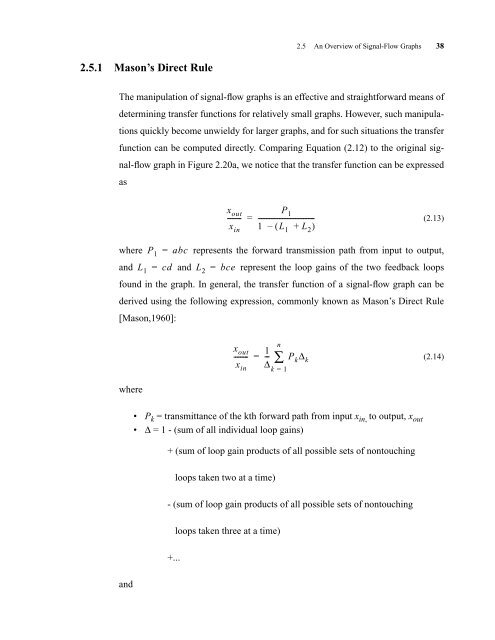CMOS Optical Preamplifier Design Using Graphical Circuit Analysis
CMOS Optical Preamplifier Design Using Graphical Circuit Analysis
CMOS Optical Preamplifier Design Using Graphical Circuit Analysis
Create successful ePaper yourself
Turn your PDF publications into a flip-book with our unique Google optimized e-Paper software.
2.5.1 Mason’s Direct Rule<br />
2.5 An Overview of Signal-Flow Graphs 38<br />
The manipulation of signal-flow graphs is an effective and straightforward means of<br />
determining transfer functions for relatively small graphs. However, such manipula-<br />
tions quickly become unwieldy for larger graphs, and for such situations the transfer<br />
function can be computed directly. Comparing Equation (2.12) to the original sig-<br />
nal-flow graph in Figure 2.20a, we notice that the transfer function can be expressed<br />
as<br />
(2.13)<br />
where = abc represents the forward transmission path from input to output,<br />
and = cd and L2 = bce represent the loop gains of the two feedback loops<br />
found in the graph. In general, the transfer function of a signal-flow graph can be<br />
derived using the following expression, commonly known as Mason’s Direct Rule<br />
[Mason,1960]:<br />
where<br />
and<br />
L 1<br />
P 1<br />
• P k = transmittance of the kth forward path from input x in, to output, x out<br />
• ∆ = 1 - (sum of all individual loop gains)<br />
+ (sum of loop gain products of all possible sets of nontouching<br />
loops taken two at a time)<br />
- (sum of loop gain products of all possible sets of nontouching<br />
+...<br />
x out<br />
--------<br />
x in<br />
x out<br />
x in<br />
loops taken three at a time)<br />
P 1<br />
= ----------------------------------<br />
1 – ( L1 + L2) 1<br />
-------- =<br />
-- ∑ Pk∆ k<br />
∆<br />
n<br />
k = 1<br />
(2.14)














